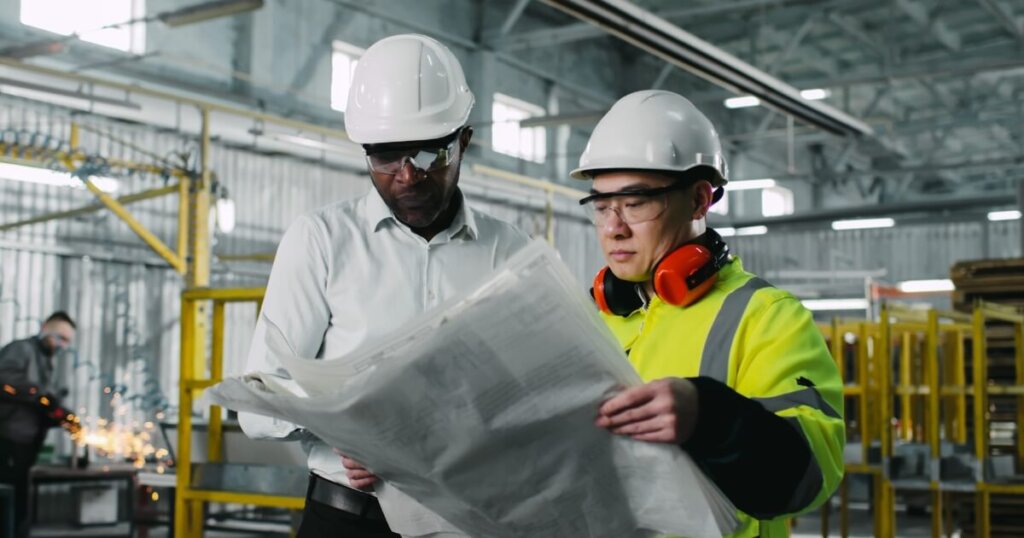When people think of strong communication skills, the first thing that may come to mind is someone great at public speaking. While public speaking is a great skill, strong communication starts with listening. In construction, engineering, and architecture, miscommunication often comes from not listening, leading to costly mistakes, wasted time, and even safety hazards. Active listening is a communication skill anyone can learn to avoid miscommunication, understand instructions clearly, and solve problems faster.
Quick look
- Active listening builds trust, improves problem-solving, and strengthens teamwork
- Construction sites and engineering projects benefit from clear communication to prevent costly mistakes
- Good listeners are more likely to be promoted to leadership roles
- Asking clarifying questions and paraphrasing ensure information is understood correctly
- Active listening helps prevent conflicts and miscommunication on job sites
What is active listening?

Active listening is the skill of being fully engaged with the speaker, understanding their message, and responding thoughtfully. This involves maintaining eye contact, using verbal and nonverbal cues like nodding or summarizing, and avoiding distractions or interruptions when someone else is speaking.
In the construction industry, active listening improves teamwork and project outcomes as it helps minimize errors. Whether an architect is discussing blueprints with a contractor or a site manager is giving instructions to a crew, a person who actively listens will be able to take away anything important.
Why active listening is an essential skill for career advancement
The best leaders in any industry are great listeners. Supervisors, foremen, and project managers who truly hear their teams build stronger relationships and make better decisions. Workers who feel heard are more likely to stay engaged, share ideas, and contribute to a positive work environment.
Listening is just as important for those on the ground. A skilled tradesperson who listens carefully to instructions, client requests, and team feedback will avoid costly mistakes and gain a reputation for reliability. That kind of professionalism is what leads to promotions and better opportunities.
How is this relevant in AEC industries?
On a construction site, one misunderstood direction can lead to wasted materials or safety risks. In engineering, overlooking a small detail in a project discussion could cause a structural flaw. In architecture, an architect working with clients must understand their vision clearly to design spaces that meet expectations.
When workers at all levels make an effort to listen, communication across teams improves, leading to smoother project execution and outcomes. A simple clarifying question or repeating back instructions can prevent thousands of dollars in mistakes.
Benefits of active listening in the trades
- Reduces job site mistakes and rework
- Improves safety by ensuring clear communication
- Builds trust among teams and improves morale
- Helps workers learn new skills faster
- Strengthens client relationships through a better understanding
- Makes problem-solving easier by encouraging collaboration
- Increases efficiency by preventing misunderstandings
How to actively listen
Paraphrase what you hear
Restating what someone said in your own words helps confirm understanding and prevents miscommunication. If a foreman gives instructions, repeating them back ensures no details are overlooked. This technique also allows the speaker to clarify any misunderstandings before work begins. In a fast-paced environment like a job site, small misinterpretations can lead to costly mistakes.
Ask clarifying questions
If something isn’t clear, speak up. Questions like, “Do you mean X or Y?” show engagement and help avoid misinterpretation. Instead of guessing and getting it wrong, a simple follow-up question can keep a project moving in the right direction. Asking for clarification also signals to the speaker that you care about accuracy.
Maintain eye contact and open body language
Making eye contact shows that you’re paying attention, and keeping an open posture (uncrossed arms, relaxed stance) makes you approachable. On a noisy job site, maintaining visual focus on the speaker is even more important, since verbal instructions can easily get lost. Shifting your body away, looking at your phone, or appearing distracted can make the other person feel unheard. Even in quick conversations, nonverbal cues set the tone for effective communication.
Avoid interrupting
Cutting someone off mid-sentence can cause you to miss important details. Letting them finish their thought shows respect and allows you to fully process what’s being said before responding. In construction, engineering, and other hands-on fields, this can mean the difference between catching a crucial safety instruction or missing it entirely. Even if you think you know what someone is going to say, waiting until they’re done prevents unnecessary misunderstandings. A short pause before responding also gives you time to gather your thoughts and answer thoughtfully.
Use nonverbal cues
Nods, facial expressions, and slight forward leans indicate your engagement in the conversation. These cues encourage the speaker to continue, making them feel heard and understood. A simple nod can reassure a supervisor that you’re absorbing their instructions, while an interested expression can make a coworker more comfortable sharing ideas.
Don’t assume—verify
Jumping to conclusions can lead to serious errors on a job site. If a project manager asks for “a half-inch cut,” verifying whether they mean depth, width, or length can prevent confusion. This practice also reduces rework and wasted materials, saving time and money.
Reflect emotions when appropriate
Sometimes, people just need to be heard before a problem can be solved. If a coworker is frustrated about a delay, acknowledging their frustration—“I hear that this is a tough situation”—can help defuse tension. This doesn’t mean you have to agree with their perspective, but it does show that you recognize their feelings. Once emotions are acknowledged, discussions are much easier to shift toward solutions.
Be present and engaged
Distractions kill good communication. If someone is speaking to you, put down your phone, stop what you’re doing, and give them your full attention. In high-stakes environments like construction sites, a missed instruction can mean safety risks or project delays. Making the conversation a priority also shows respect and improves teamwork.
Bottom line
In the trades, listening is just as important as skill and experience. Whether on a job site, in a design meeting, or managing a team, strong listening skills help avoid mistakes, build trust, and increase the chances of getting a raise.
Want to sharpen your communication skills and stay ahead in the industry? Subscribe to our newsletter and follow us on social media for more insights on professional growth in construction, engineering, and architecture.


